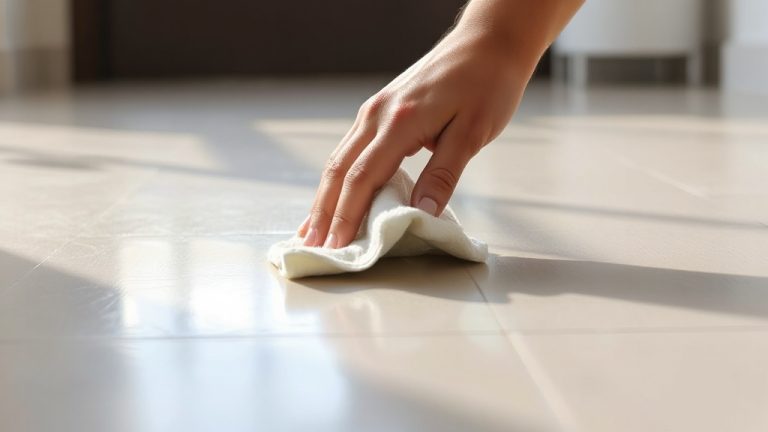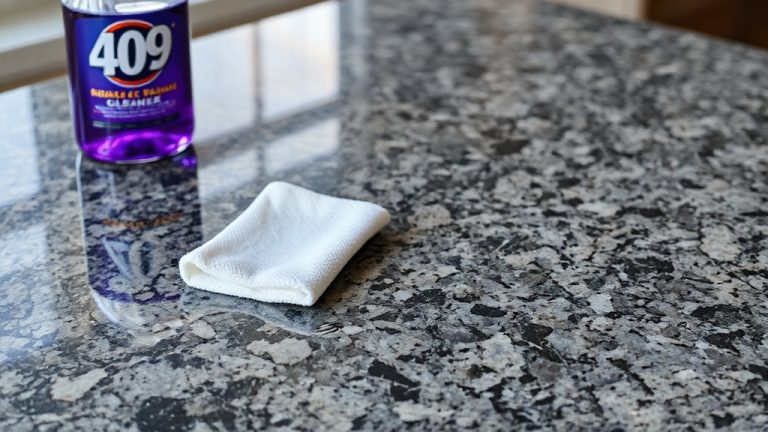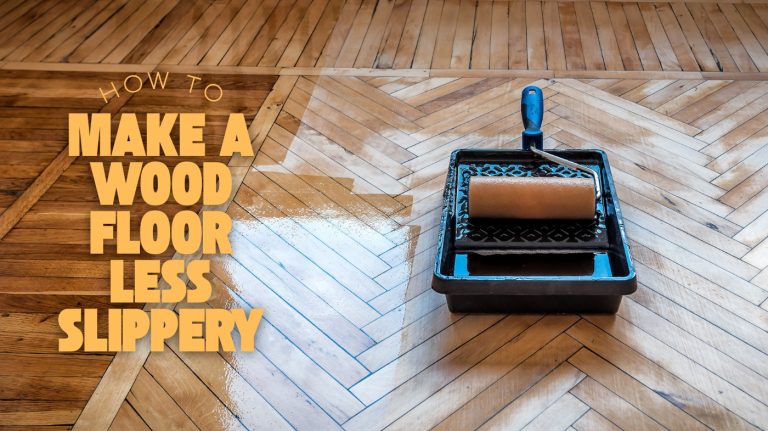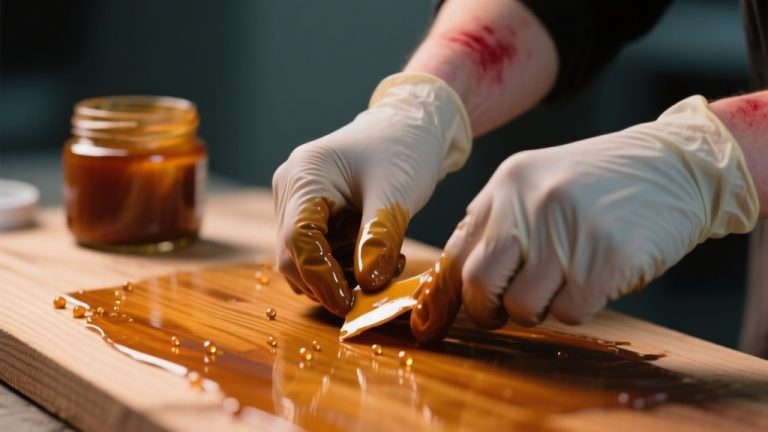Does Vinegar Hurt Concrete? Discover the Surprising Truth
Vinegar can hurt your concrete because its acetic acid reacts with the calcium carbonate in the material, causing surface erosion and weakening the internal structure over time.
Prolonged exposure increases the risk of micro-pitting, discoloration, and crack formation, reducing concrete’s durability. While vinegar is a useful, eco-friendly cleaner, improper or frequent use can cause damage.
Understanding the chemical effects and safe application methods will help you protect your concrete effectively.
Key Takeaways
- Vinegar’s acetic acid reacts with concrete’s calcium carbonate, causing surface erosion and weakening structural integrity over time.
- Prolonged or repeated vinegar exposure leaches calcium, reducing concrete strength and increasing micro-cracks and fissures.
- Surface signs of vinegar damage include pitting, discoloration, dull texture, and etched spots on polished concrete.
- Diluted vinegar can clean stains safely if applied briefly and rinsed thoroughly to minimize concrete damage.
- Alternative cleaners or professional services are recommended for concrete to avoid long-term acid damage from vinegar.
Chemical Reaction Between Vinegar and Concrete
Although vinegar is a weak acid, its acetic acid content reacts chemically with concrete’s primary component, calcium carbonate, initiating a process that gradually alters the surface.
The acetic acid attacks calcium carbonate (CaCO3), producing calcium acetate, water, and carbon dioxide gas (CaCO3 + 2CH3COOH → Ca(CH3COO)2 + H2O + CO2).
Calcium acetate’s higher solubility facilitates gradual leaching, accelerating surface erosion. The released CO2 induces micro-pitting, weakening the surface structure over time.
Vinegar also targets cement hydration products like calcium hydroxide, reducing the cement’s binding strength and compromising aggregate adhesion.
Prolonged exposure to vinegar can result in pitting, rough textures, and a weakened concrete matrix, increasing susceptibility to cracks and physical damage, which highlights the risk of deterioration.
This chemical interaction alters the concrete’s surface chemistry, potentially changing color and texture.
While the reaction is mild, repeated exposure or higher acid concentrations increase degradation rates, especially on polished or decorative concrete where surface integrity is critical.
Effects of Prolonged Vinegar Exposure on Concrete
You’ll notice that prolonged vinegar exposure accelerates concrete weakening by dissolving calcium compounds, leading to surface erosion characterized by pitting and roughness.
This degradation compromises the material’s structural integrity, increasing the risk of cracks and physical damage.
Because concrete contains cement, which reacts chemically with substances, exposure to acidic materials like vinegar can cause chemical reactions damaging the surface and structure of the concrete (chemical reaction).
Concrete Weakening Mechanism
When vinegar repeatedly contacts concrete, the acetic acid reacts with calcium carbonate in the material, forming calcium acetate and increasing the solubility of essential calcium compounds. This reaction leaches calcium from the concrete, undermining its structural matrix.
You’ll notice:
- Progressive loss of calcium reduces cohesion and compressive strength, impairing load-bearing capacity.
- Acid penetration through concrete porosity accelerates internal micro-cracking and fissure formation.
- Concrete quality factors—like water-cement ratio and curing—modulate susceptibility to acid attack, with poorer mixes degrading faster. Additionally, vinegar is not recommended for use on concrete surfaces, as it may damage surrounding cement due to its acidic nature (vinegar is not recommended).
Over time, these chemical and physical changes cumulatively weaken the concrete’s integrity, making it more vulnerable to mechanical stresses.
Although damage initiates slowly, prolonged vinegar exposure systematically compromises the concrete’s durability, necessitating eventual maintenance or repair to mitigate structural risks.
Surface Erosion Signs
Since vinegar contains acetic acid, prolonged exposure causes noticeable surface erosion on concrete.
You’ll observe pitting and a roughened texture as the acid reacts with calcium carbonate, dissolving the cement binder. This etching creates pinholes and dulls polished finishes, reducing concrete’s aesthetic appeal.
Over time, the surface loses gloss, and discoloration may appear, signaling chemical degradation. Moisture and humidity accelerate these effects by enhancing calcium acetate solubility, increasing erosion rates.
The weakened surface becomes more susceptible to micro-cracks, although this discussion excludes structural damage risks.
Additionally, even a single spill of diluted vinegar can cause etching and leave ghost impressions on polished concrete, demonstrating its vulnerability to acid attack (polished concrete vulnerability).
You should note that continuous vinegar application compromises durability by degrading surface integrity, making it vulnerable to environmental factors.
Structural Damage Risks
Although vinegar is a weak acid, its prolonged exposure can compromise concrete’s structural integrity by chemically interacting with and leaching calcium compounds from the cement matrix.
This process gradually weakens the concrete, reducing its load-bearing capacity and increasing vulnerability to physical damage.
Vinegar contains acetic acid, which reacts with the alkaline components of concrete, leading to the degradation of cement. When you repeatedly expose concrete to vinegar, you risk:
- Leaching calcium carbonate as acetic acid reacts to form soluble calcium acetate, diminishing cement cohesion.
- Progressive degradation of the cement binder, leading to microcracking and reduced mechanical strength.
- Heightened susceptibility to fractures and structural failure over time due to compromised matrix integrity.
While occasional vinegar contact poses minimal risk, continuous exposure accelerates deterioration.
To preserve concrete strength, limit vinegar use on structural surfaces and consider sealing or protective coatings to mitigate chemical ingress.
Benefits of Using Vinegar for Cleaning Concrete
Because vinegar effectively breaks down and lifts stains on concrete, it serves as a powerful cleaning agent for various applications.
You can use distilled white vinegar, either neat or diluted, to target oil stains, mold, algae, and even paint residues by adjusting concentration and contact time.
Its biodegradable and non-toxic nature makes it an environmentally responsible choice, minimizing chemical exposure and health risks during cleaning.
Vinegar’s versatility allows application on driveways, patios, and porches, using simple tools like brushes for scrubbing.
However, it is important to use vinegar with caution on polished or unfinished concrete to prevent potential surface damage from prolonged exposure to its acidity safe application.
Regular use prevents biological growth that degrades concrete surfaces and restores brightness by removing discolorations.
Additionally, vinegar’s affordability and accessibility enable you to maintain concrete efficiently without specialized equipment, supporting sustainable, cost-effective upkeep while enhancing the appearance and longevity of your concrete surfaces.
Potential Risks and Damage From Vinegar Use
While vinegar offers effective cleaning benefits for concrete, its acidic nature can pose significant risks if not used carefully.
When vinegar contacts concrete, its acetic acid reacts with calcium carbonate, causing chemical dissolution and surface erosion. This weakens the concrete matrix, reducing structural integrity over time.
It is important to note that only distilled white vinegar is environmentally safe for cleaning concrete to minimize additional damage.
Vinegar’s acidity chemically erodes concrete, weakening its structure and causing surface damage over time.
You should be aware of these key risks:
- Prolonged exposure leads to pitting, dulling, and irreversible etching, especially on polished or sealed surfaces.
- Saturation and repeated use accelerate degradation, causing cracking and cumulative damage beyond superficial stains.
- Residual vinegar left on the surface increases chemical attack, so limiting contact time is critical to avoid long-term wear.
Safe Application Techniques for Vinegar on Concrete
When applying vinegar to concrete, you must dilute it with water to reduce acidity and minimize surface damage.
Before application, clear the surface of debris to guarantee uniform contact. Use a spray bottle to apply the solution evenly and a soft brush or sponge for gentle scrubbing.
Distilled white vinegar is the preferred type for cleaning concrete due to its effectiveness and safety as an eco-friendly option.
Limit exposure time—especially on polished or sensitive concrete—to prevent etching or discoloration. Always test a small, inconspicuous area first to detect adverse reactions.
After cleaning, thoroughly rinse the area with water to neutralize residual acid and prevent ongoing chemical interaction. Wear gloves and goggles for protection, and guarantee adequate ventilation to avoid irritation.
Comparing Vinegar to Other Concrete Cleaning Solutions
When choosing between vinegar and bleach for concrete cleaning, you’ll find vinegar offers safer, eco-friendly stain removal, while bleach excels at disinfection but risks surface degradation.
Commercial chemical cleaners provide stronger stain removal but often pose environmental and health hazards that vinegar avoids.
For persistent or heavy stains, professional cleaning services might deliver superior results by combining specialized products and techniques beyond what vinegar can achieve.
Vinegar Versus Bleach
How do vinegar and bleach compare as concrete cleaning agents? Vinegar excels at breaking down stains like oil and pet urine due to its acidic nature, while bleach is superior for disinfecting and removing mold.
When choosing between them, consider these factors:
- Effectiveness: Vinegar removes a wider range of stains; bleach targets biological contaminants.
- Damage Potential: Vinegar can degrade concrete if left too long; bleach is gentler on concrete but harmful to plants.
- Safety and Environment: Vinegar is biodegradable and eco-friendly; bleach requires careful handling to avoid toxic fumes and environmental harm.
You should use vinegar for flexible stain treatment with short contact time, and bleach for thorough mold disinfection, ensuring proper dilution and ventilation for both.
Frequently Asked Questions
Can Vinegar Remove Graffiti From Concrete Surfaces?
You can use vinegar to remove fresh or lightly applied graffiti from concrete since its acidity helps break down paint adhesion. However, it struggles with older, thick, or deeply embedded graffiti on porous surfaces.
Applying a vinegar-water mix, letting it sit, then scrubbing may work for light stains, but stubborn marks often need stronger chemicals or mechanical methods. Keep in mind repeated use requires caution to avoid surface damage.
Is Vinegar Effective Against Concrete Efflorescence?
Imagine vinegar as a skilled locksmith, releasing stubborn mineral deposits on concrete surfaces.
You’ll find vinegar, diluted 20–50%, effectively breaks down efflorescence crystals by chemically dissolving salts. When you apply and scrub it, you disrupt the mineral buildup without harsh damage.
While not as aggressive as muriatic acid, vinegar offers a safer, cost-effective method for treating efflorescence—making it a reliable tool in your concrete maintenance arsenal.
How Does Vinegar Affect Concrete Sealants?
You should know vinegar’s acetic acid can gradually degrade concrete sealants, especially acrylic solvent- or water-based types, which offer limited acid resistance.
While vinegar won’t strip most modern sealants immediately, repeated exposure dulls or weakens them, compromising protection.
Once the sealant deteriorates, the underlying concrete becomes vulnerable to damage like staining and erosion. To maintain sealant integrity, limit vinegar use and regularly inspect for signs of chemical breakdown.
Can Vinegar Clean Concrete Driveway Tire Marks?
Imagine you sprayed diluted vinegar on stubborn tire marks on your driveway, then scrubbed vigorously.
Vinegar can break down some stains chemically, helping remove light marks, but it often won’t fully erase tire marks after one treatment. You’ll need repeated applications and mechanical scrubbing.
For tougher marks, specialized cleaners like mold-killing detergents or diluted bleach work better. Vinegar’s mild acidity limits its effectiveness on heavy grease or deep tire stains.
Is Vinegar Safe for Cleaning Concrete Pavers in Gardens?
You can use vinegar cautiously to clean concrete pavers in gardens because it’s biodegradable and safe for surrounding plants.
However, its acidity may weaken paver surfaces if applied frequently or in high concentrations. To protect your pavers, dilute vinegar and limit use to occasional cleaning.
Always test a small area first to guarantee no damage occurs, especially with sensitive materials. Consider gentler alternatives if you notice any deterioration.
Think Before You Spray: Protect Your Concrete Surface
You might think vinegar will instantly dissolve your concrete driveway, but it’s not that dramatic—though prolonged use can cause surface etching due to its acidic nature.
While vinegar is a handy, mild cleaner for minor stains, overusing it risks degrading the concrete’s integrity. To avoid turning your sturdy slab into Swiss cheese, apply vinegar cautiously and sparingly.
When in doubt, call a professional—your concrete deserves more than a kitchen experiment gone wrong.







